A novel calcium-dependent mechanism of acquired resistance to IGF-1 receptor inhibition in prostate cancer cells
- PMID: 25344862
- PMCID: PMC4253414
- DOI: 10.18632/oncotarget.2346
A novel calcium-dependent mechanism of acquired resistance to IGF-1 receptor inhibition in prostate cancer cells
Abstract
Inhibition of the mitogenic insulin-like growth factor receptor 1 (IGF-1R) signaling axis is a compelling treatment strategy for prostate cancer. Combining the IGF-1R inhibitor ganitumab (formerly AMG 479) with standard of care androgen-deprivation therapy greatly delays prostate cancer recurrence in xenograft models; however, a significant proportion of these tumors ultimately acquire resistance to ganitumab. Here we describe the development of a stable and reproducible ganitumab-resistant VCaP human prostate cancer cell derivative termed VCaP/GanR to investigate the mechanism of acquired resistance to IGF-1R inhibition. Unlike parental VCaP, VCaP/GanR did not undergo apoptosis following ganitumab treatment. VCaP/GanR did not express increased levels of IGF-1R, insulin receptor, or phospho-AKT compared to parental VCaP. VCaP/GanR exhibited increased levels of phospho-S6 indicative of increased mTOR activity. However, acquired resistance to ganitumab was not dependent on increased mTOR activity in VCaP/GanR. Phospho-proteomic arrays revealed alterations in several calcium-regulated signaling components in VCaP/GanR compared to VCaP. Reduction of intracellular calcium using cell-permeable calcium-specific chelators restored ganitumab sensitivity to VCaP/GanR through inhibition of cell-cycle progression. These data suggest a new mechanism of resistance to IGF-1R inhibition involving calcium-mediated proliferation effects. Such pathways should be considered in future clinical studies of IGF-1R inhibitors in prostate cancer.
Conflict of interest statement
Pedro J. Beltran is an employee of and owns stock in Amgen, Inc.
Figures

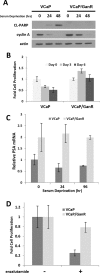
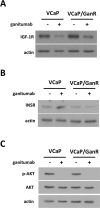
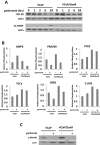
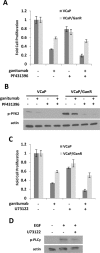
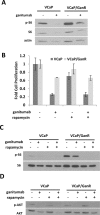
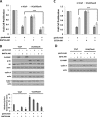
Similar articles
-
Targeting IGF-IR with ganitumab inhibits tumorigenesis and increases durability of response to androgen-deprivation therapy in VCaP prostate cancer xenografts.Mol Cancer Ther. 2013 Apr;12(4):394-404. doi: 10.1158/1535-7163.MCT-12-0648. Epub 2013 Jan 24. Mol Cancer Ther. 2013. PMID: 23348048 Free PMC article.
-
Effect of a low-fat diet combined with IGF-1 receptor blockade on 22Rv1 prostate cancer xenografts.Mol Cancer Ther. 2012 Jul;11(7):1539-46. doi: 10.1158/1535-7163.MCT-11-1003. Epub 2012 May 4. Mol Cancer Ther. 2012. PMID: 22562985 Free PMC article.
-
Ridaforolimus (MK-8669) synergizes with Dalotuzumab (MK-0646) in hormone-sensitive breast cancer.BMC Cancer. 2016 Oct 20;16(1):814. doi: 10.1186/s12885-016-2847-3. BMC Cancer. 2016. PMID: 27765027 Free PMC article.
-
Plasma and tissue insulin-like growth factor-I receptor (IGF-IR) as a prognostic marker for prostate cancer and anti-IGF-IR agents as novel therapeutic strategy for refractory cases: a review.Mol Cell Endocrinol. 2011 Sep 15;344(1-2):1-24. doi: 10.1016/j.mce.2011.07.002. Epub 2011 Jul 18. Mol Cell Endocrinol. 2011. PMID: 21782884 Review.
-
Insulin receptor (IR) and insulin-like growth factor receptor 1 (IGF-1R) signaling systems: novel treatment strategies for cancer.Med Oncol. 2014 Jan;31(1):805. doi: 10.1007/s12032-013-0805-3. Epub 2013 Dec 14. Med Oncol. 2014. PMID: 24338270 Review.
Cited by
-
The voltage gated Ca(2+)-channel Cav3.2 and therapeutic responses in breast cancer.Cancer Cell Int. 2016 Mar 31;16:24. doi: 10.1186/s12935-016-0299-0. eCollection 2016. Cancer Cell Int. 2016. PMID: 27034617 Free PMC article.
-
Design and Synthesis of Novel N-Benzylidene Derivatives of 3-Amino-4-imino-3,5-dihydro-4H-chromeno[2,3-d]pyrimidine under Microwave, In Silico ADME Predictions, In Vitro Antitumoral Activities and In Vivo Toxicity.Pharmaceuticals (Basel). 2024 Apr 2;17(4):458. doi: 10.3390/ph17040458. Pharmaceuticals (Basel). 2024. PMID: 38675418 Free PMC article.
-
Beyond standard therapy: drugs under investigation for the treatment of gastrointestinal stromal tumor.Expert Opin Investig Drugs. 2015;24(8):1045-58. doi: 10.1517/13543784.2015.1046594. Epub 2015 Jun 22. Expert Opin Investig Drugs. 2015. PMID: 26098203 Free PMC article. Review.
-
Automation, live-cell imaging, and endpoint cell viability for prostate cancer drug screens.PLoS One. 2023 Oct 10;18(10):e0287126. doi: 10.1371/journal.pone.0287126. eCollection 2023. PLoS One. 2023. PMID: 37815978 Free PMC article.
-
Prognostic value of IGF-1R expression in bone and soft tissue sarcomas: a meta-analysis.Onco Targets Ther. 2015 Jul 29;8:1949-55. doi: 10.2147/OTT.S88293. eCollection 2015. Onco Targets Ther. 2015. PMID: 26251617 Free PMC article.
References
-
- Siegel R, Naishadham D, Jemal A. Cancer statistics, 2012. CA Cancer J Clin. 2012;62(1):10–29. - PubMed
-
- Breuhahn K, Longerich T, Schirmacher P. Dysregulation of growth factor signaling in human hepatocellular carcinoma. Oncogene. 2006;25(27):3787–3800. - PubMed
-
- Grothey A, Voigt W, Schober C, Muller T, Dempke W, Schmoll HJ. The role of insulin-like growth factor I and its receptor in cell growth, transformation, apoptosis, and chemoresistance in solid tumors. J Cancer Res Clin Oncol. 1999;125(3–4):166–173. - PubMed
-
- Beltran PJ, Chung YA, Moody G, Mitchell P, Cajulis E, Vonderfecht S, Kendall R, Radinsky R, Calzone FJ. Efficacy of ganitumab (AMG 479), alone and in combination with rapamycin, in Ewing's and osteogenic sarcoma models. J Pharmacol Exp Ther. 2011;337(3):644–654. - PubMed
Publication types
MeSH terms
Substances
Grants and funding
LinkOut - more resources
Full Text Sources
Other Literature Sources
Medical
Miscellaneous

